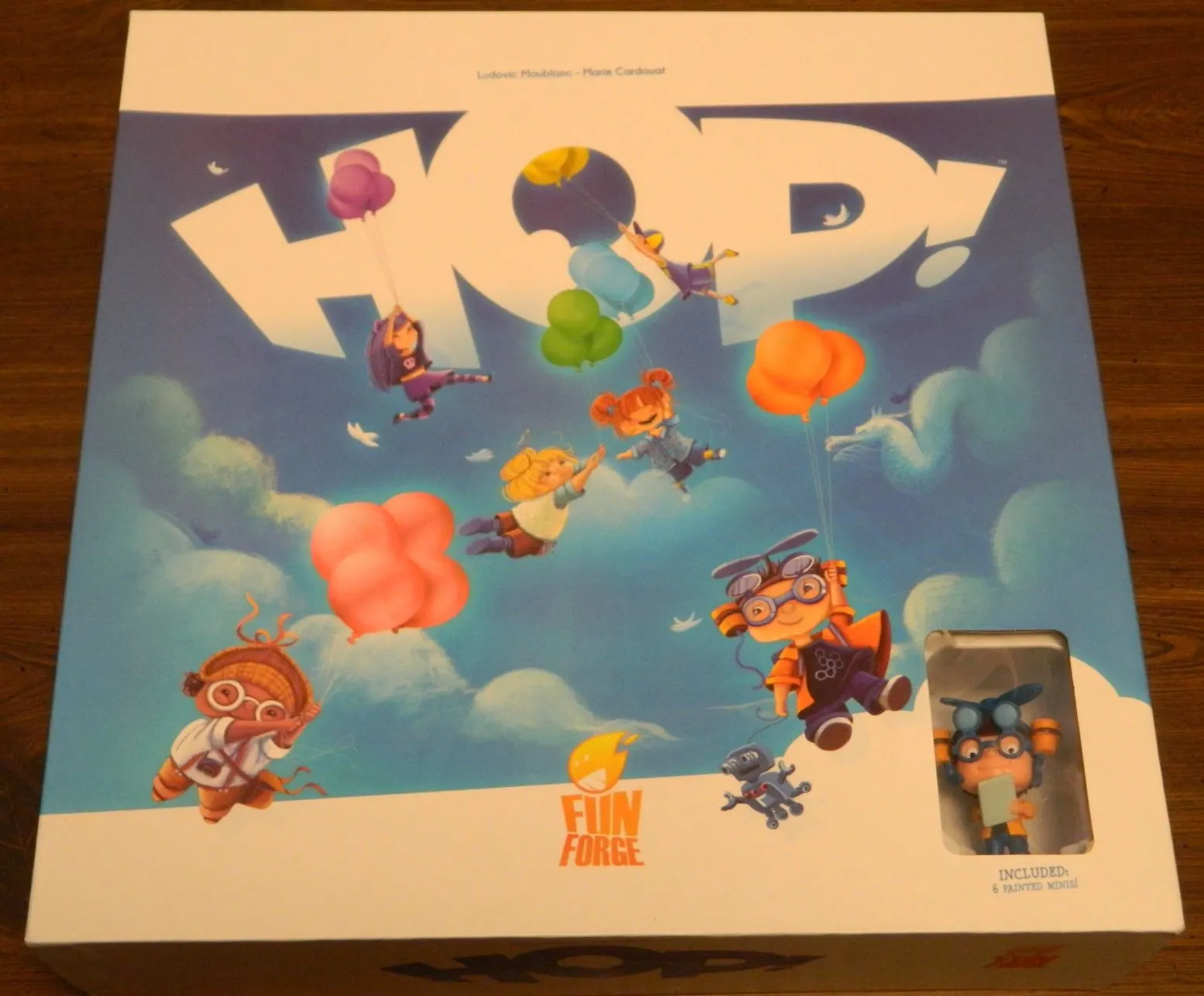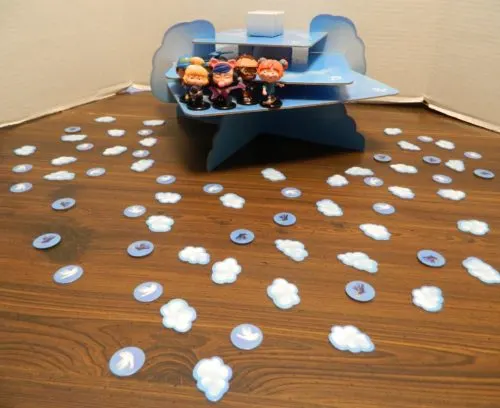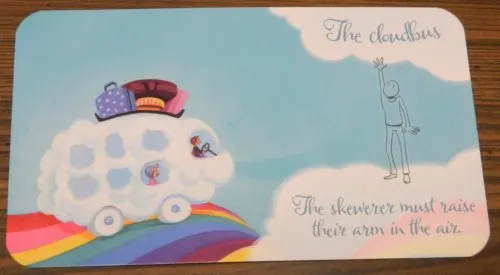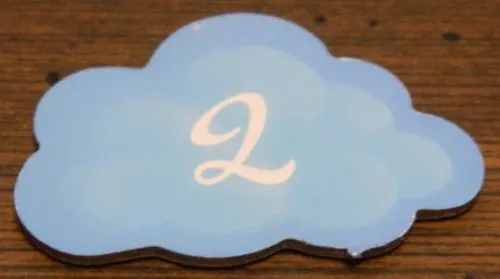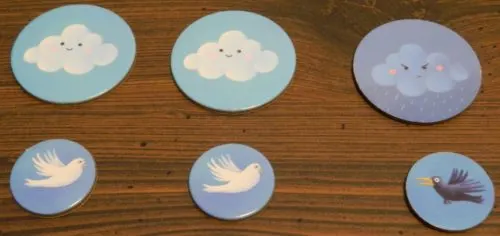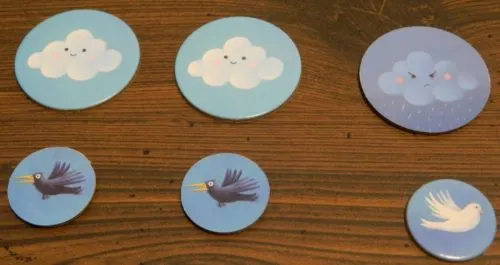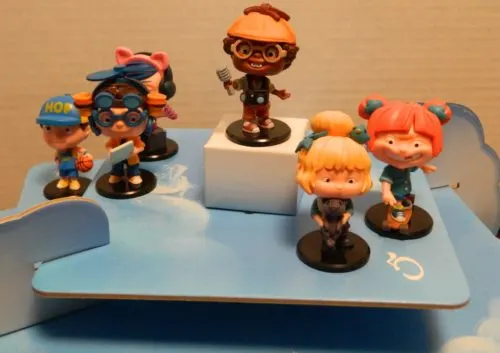With the number of board games that I have looked at here on Geeky Hobbies it is rare when I found a board game that utilizes a unique concept that I haven’t seen before. In particular I have played a lot of different dexterity games. I can’t ever recall playing a game quite like Hop! before though. Released back in 2016 Hop! is a different take on your typical dexterity game as it is based around the classic game Ring Toss. I honestly had never heard of the game until recently, but after acquiring the game on sale I was intrigued. Hop! is arguably the most overproduced game that I have ever played which will be a little too silly for some players, but the gameplay overcomes that to create a fun dexterity game that families should enjoy.
How to Play Hop!
Setup
- Assemble the gameboard and place it in the middle of the table.
- Spread the Cloud Tokens around the table with the numbers placed face down.
- Spread the Bird Tokens around the table. It doesn’t matter which side is face up.
- Shuffle the Dare Cards to form the draw deck. Place the deck face down where the players can reach it.
- Each player chooses a character. They will take the following components based on their choice:
- Figurine
- Character Board
- 5 Balloons of their chosen color
- Bet Token
- Each player will place their figurine on the one space of the gameboard.
- The youngest player will be the first player.
Playing the Game
Preparing For the Challenge
A player will begin their turn by drawing the top card from the Dare Card deck. Written on the card is a challenge that the current player will have to complete with other players helping or hindering their attempt.
The cards utilize a number of different terms for roles that the players will take. These roles are as follows:
- Hurler: The current player will always be the Hurler. The Hurler is responsible for throwing the rainbow hoping to get it to land on the Skewer’s finger.
- Skewer: The current player will pick another player to be the Skewer who will help them with their challenge. The Skewer will start each round by placing one of their elbows on the table (their choice) and pointing their index finger up into the air.
- Assister: The current player will sometimes pick a player to be an Assister. The Assister role is only chosen if the card specifically mentions it. The Assister will help the Hurler and Skewer in the way mentioned on the card.
- Turbulator: The current player will choose a player to be the Turbulator if the card mentions the role. The Turbulator’s job is to try and prevent the other players from being successful with the throw. They can use whatever tactics that are specifically mentioned on the card to interfere with the other players.
The card that the current player drew will outline a challenge that the players have to complete. The basic objective of each round is for the Hurler to throw the rainbow so it lands around the index finger of the Skewer. The Skewer may not use anything else to help them catch the rainbow outside of their index finger, unless the card specifically mentions something.
If for some reason the players are unable to attempt the challenge, a new Dare Card is drawn.
Betting on the Outcome
All player not chosen for a role will have the opportunity to bet on the outcome of the challenge. Each of these players will use their Bet Tokens to indicate their choice. If they think the challenge will be a success they will place the happy side face up. If they think the players will fail they will place the unhappy side face up. All bets should be made in secret so each player should cover up their token with one of their hands.

For this round the first two players bet that the Hurler and Skewer would succeed. The last player bet that they would fail.
The Challenge
After all of the players not competing in the challenge have placed their bets, the challenge will commence. The following rules must be followed while trying to complete a challenge:
- The Hurler must throw the rainbow from below the table.
- The Skewer must keep their elbow on the table until the rainbow is thrown. Once the rainbow is thrown the Skewer can move their arm however they would like.
A challenge is successful if all of the conditions on the card were met and the Skewer successfully catches the rainbow. The challenge is failed if the Skewer fails to catch the rainbow or one of the conditions on the card are broken.
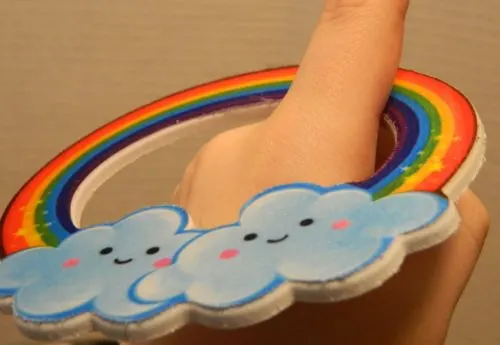
This Skewer has successfully caught the rainbow on their index finger. Therefore the players successfully completed the challenge.
Scoring
If the challenge was successful rewards and penalties are awarded as follows:
- The Hurler will move their Figurine up one space on the gameboard.
- The Skewer and Assister will get to take a Cloud Token. When choosing a cloud token a player will randomly draw one of the face down tiles on the table. The player who draws it can look at its value, but they should keep it secret from the other players.
- The Turbulator won’t receive or lose anything.
- Any players that bid that the players will be successful will get to take one of the Bird Tokens from the table and place it in front of themselves. They will place it with the dove side face up.
- Any players that bid that the players would fail will take a Bird Token and turn it crow side up in front of themselves.
If the players failed at the challenge the following rewards and penalties are given out:
- The Hurler will lose one of their Balloon Tokens.
- The Skewer and Assisster will not gain or lose anything.
- The Turbulator will get to take a Cloud Token.
- Players that bet that they would be successful will take a Crow Token.
- Players that bet that the players would fail will take a Dove Token.
Before starting the next round players will check the number of tokens in front of them.
If a player has three Dove Tokens they will turn them in and move their Figurine up one space on the gameboard.

This player has collected three Dove Tokens. They can turn these token in to move their playing piece up one space on the gameboard.
If a player has three Crow Tokens they will turn them in and lose one of their Balloon Tokens.
Another round will then be played unless one of the end game conditions are met. The player to the left of the current Hurler will become the next Hurler.
End of Game
The game ends when either one of the players reach the top of the gameboard or a player loses their last Balloon Token. Any player that loses all of their Balloon Tokens will place their Figurine next to the gameboard.
All of the players will then tally their final score. A player’s final score is equal to the player’s position on the gameboard plus the number on each of the Cloud Tokens they collected during the game.
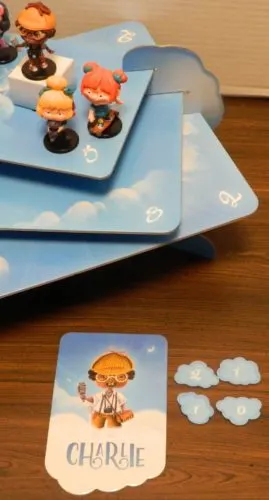
At the end of the game the Charlie player will score seven points for reaching the last space. They will also score four points for the Cloud Tokens they collected throughout the game. They will score a total of eleven points.
The player with the most points wins the game. If there is a tie, the tied player higher on the gameboard wins. If there is still a tie, the tied players share the victory.
My Thoughts on Hop!
At the most basic level I would say that Hop! is basically a new take on the classic game Ring Toss. Instead of trying to throw a ring on a stationary peg, you will be using another player’s finger. One player will throw the rainbow hoping to get it on another player’s index finger. That player can move their arm in order to try and help catch the rainbow. Other than a non-stationary target, the other major change to Hop! is the addition of different challenges. Very rarely will the players be able to just throw and catch the ring. Usually you will have some sort of hindrance impacting your ability to catch or throw the rainbow.
If it wasn’t apparent from the previous paragraph, the best way to describe Hop! is to say that it is a pretty silly dexterity game. I have to say that I have played a lot of dexterity games and I can’t recall playing one quite like Hop! before. While the concept of a Ring Toss has been around for a very long time, the dexterity genre has not used it as much as I would have expected. Anyone who has played this type of game before probably already has a good idea of whether they will enjoy the game. Adding in using another player’s finger as a target as well as the various challenges does distinguish the game though. I honestly think these improve upon a normal Ring Toss as they keep things interesting for longer.
When most people first see Hop! they will probably think that it is a children’s game. In some ways I agree with this assessment. The game is really easy to play. The game has more rules than it probably needed, but you basically just toss rings hoping that they will land on the player’s finger. The game has a recommended age of 6+ which seems right. You might have to read off the cards to younger children, but I don’t see them having any problems understanding the rules.
The other reason why I think the game will work better with families and adults at heart is that the game is quite silly. If you are a really serious gamer I don’t see you enjoying Hop!. While playing the game you likely will regularly make a fool out of yourself. Basically if the game’s premise sounds stupid to you, it likely will be. The game has very little strategy as you just have to hope you and the Skewer are on the same page. There is also quite a bit of luck as some of the challenges are easier than others.
Despite its silliness likely turning off some players, it is also probably the game’s greatest strength. Simply put if you think the premise sounds interesting, you will likely enjoy it. Hop! simply is not a game that you are meant to take seriously. While the game has a winner, it doesn’t really matter who wins. If you are a really competitive player this might frustrate you. Some players are going to be better at the game than others, but there are too many variables where you can never have full control over how well you do. If you want a simple silly game that you can turn off your brain while playing and just focus on enjoying it, you likely will have fun with the game. I would say that most fans of dexterity games should enjoy their time with Hop!.
Hop!’s simplicity also means that the game generally plays pretty quickly. The game has some pretty firm rules in place which makes the playtime pretty consistent. If players are good at the game they likely will reach the top pretty quickly. On the other hand bad players will end the game by losing their last balloon. There isn’t any player elimination so everyone will stay in the game until the very end. The number of players will have some impact on the game’s length as more players will take longer than fewer players. I would say that most games will likely end within 30 or so minutes though.
While first appearances might make Hop! look like a children’s/family game, I was honestly a little surprised by how difficult the game actually is. My group is generally pretty good at dexterity games and yet we struggled with Hop!. I might not seem all that difficult to throw a ring on another player’s finger, but in action it kind of is. First the two players have to be in sync. I actually liked this aspect of the game. Hop! is genuinely a good cooperative experience as players need to work well together in order to succeed. The designers were also smart to reward the players that help the current player as they otherwise could purposely fail. In fact in most cases the Skewer will score the same or more points than the current player. There might be a few times where a player could sabotage their teammate, but players are usually better off helping one another.
Probably the biggest contributor to the game’s surprisingly high difficulty is that the game actually relies on quite a bit of skill. To be successful at a challenge both the Hurler and the Skewer have to do their jobs. The Hurler needs to do a good job getting the rainbow near their teammate while also allowing it to stay in the air for long enough that the Skewer can adjust if the throw is not quite on target. Even if the throw is quite good, it is still not super easy to catch the rainbow. It requires quite a bit of hand eye coordination in order to be successful. Some players are naturally going to be better at this than others. This isn’t even factoring in the unique requirements for the challenges which can make things considerably more difficult.
I don’t know if I have ever said this about a board game’s components before, but Hop’s are both fantastic and also mostly worthless. There are a lot of things that I really liked about the components. The character figurines are surprisingly detailed and look fantastic. Outside of really expensive board games, I think it would be hard to find a game with better looking figures. On top of the figures the game’s whole art style is fantastic. That is not that surprising as the game’s art was done by Marie Cardouat who is probably most known in the industry for Dixit. The artwork is fantastic and actually shares a very similar style to Dixit. The rainbows are made of a foam like substance which should last longer than you would initially expect from this type of game. On top of all of this the cardboard is quite thick and the 3D gameboard looks impressive in the middle of the table. I will say that my copy of the game did have some cardboard pieces that stuck together which left behind some tiny to small white spots on some pieces. The pieces have kind of a strong smell to them as well.
The biggest problem that I had with the components is that most of them are totally unnecessary. Honestly the only components from the game that you absolutely need are the rainbow and the cards. All of the rest of the components aren’t that necessary. The components look nice, but they weren’t really needed. The gameboard and figurines could have been replaced with a simple scoreboard or some other way of keeping score. The game was simply overproduced. This leads to two main problems for the game. First the game’s initial retail price was way too high. If you can get a good deal on the game this isn’t really an issue. I wouldn’t recommend buying the game for its original price though. The other problem is that with all of the extra components the box is much larger than it needed to be. The box is quite heavy and it could have easily been shrunk to half of its size if not even further if the components that weren’t even necessary weren’t included in the game.
Should You Buy Hop!?
Hop! is kind of a peculiar game. In many ways it feels like if you took a traditional Ring Toss and tweaked it to make it a cooperative game. Basically one player throws the rainbow and another player tries to catch it on their index finger. Additionally the game add various challenges to make things more interesting. Hop! is a really silly game which will make it really appeal to some players while others will hate it. Between the theme and the simple gameplay it likely will appeal to children. I was actually surprised that the game is more challenging than I was expecting though. Some players will likely be good at the game and others will really struggle. Hop!’s components are fantastic, but many of them feel kind of pointless.
My recommendation for Hop! comes down to your thoughts on the premise. If you don’t generally like silly games or think the premise sounds stupid, I doubt Hop! will appeal to you. Those that are intrigued by the premise though and don’t mind a silly game should enjoy Hop! and should consider picking it up if you can get a good deal on it.

